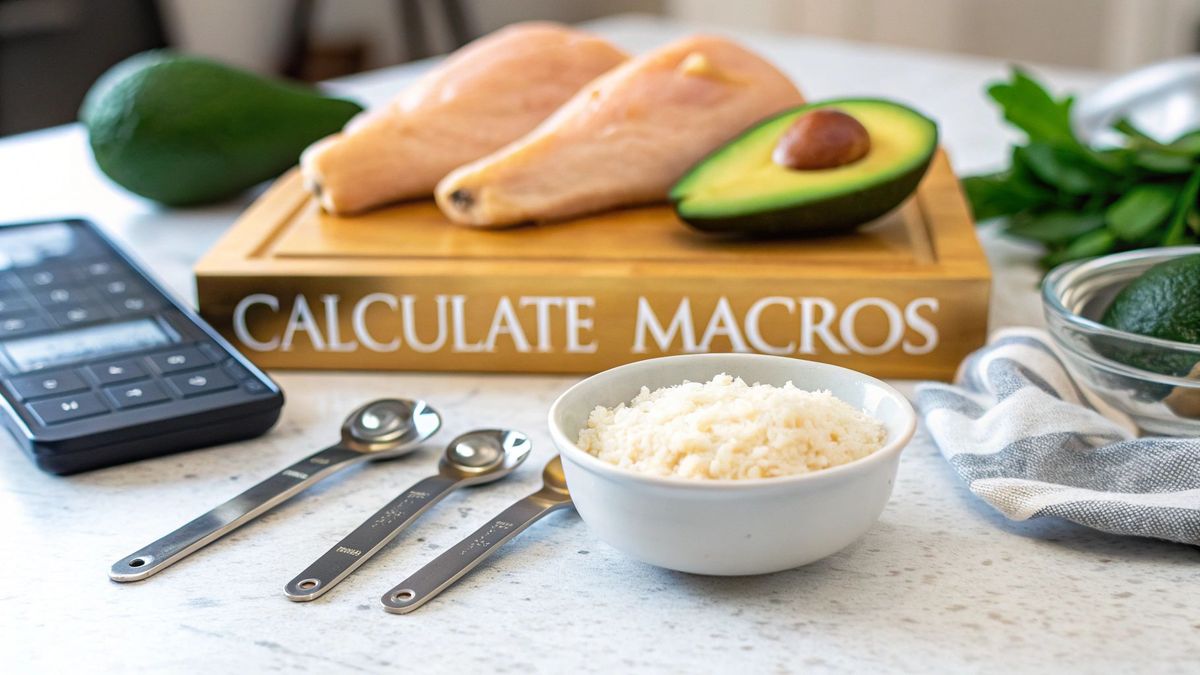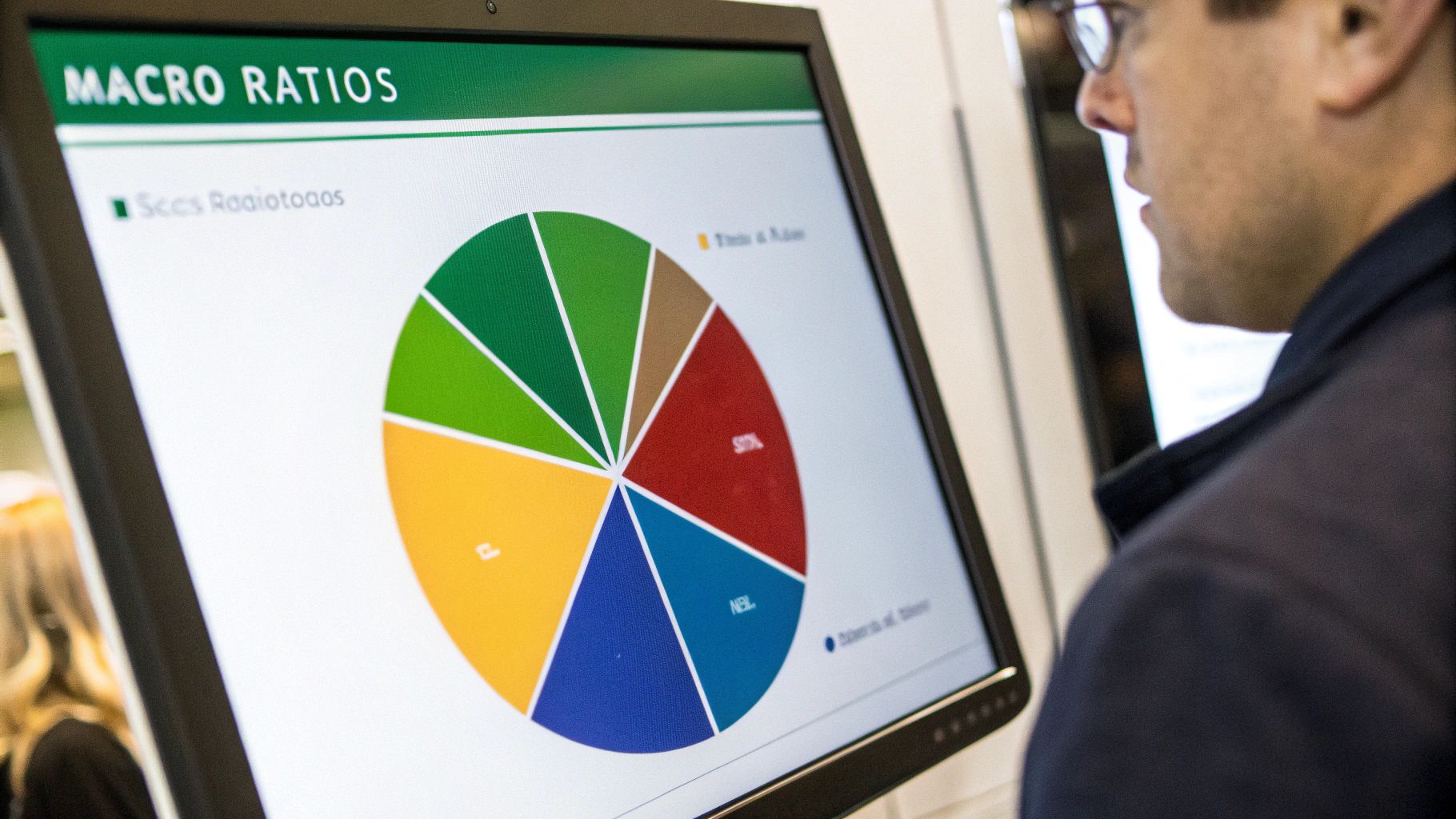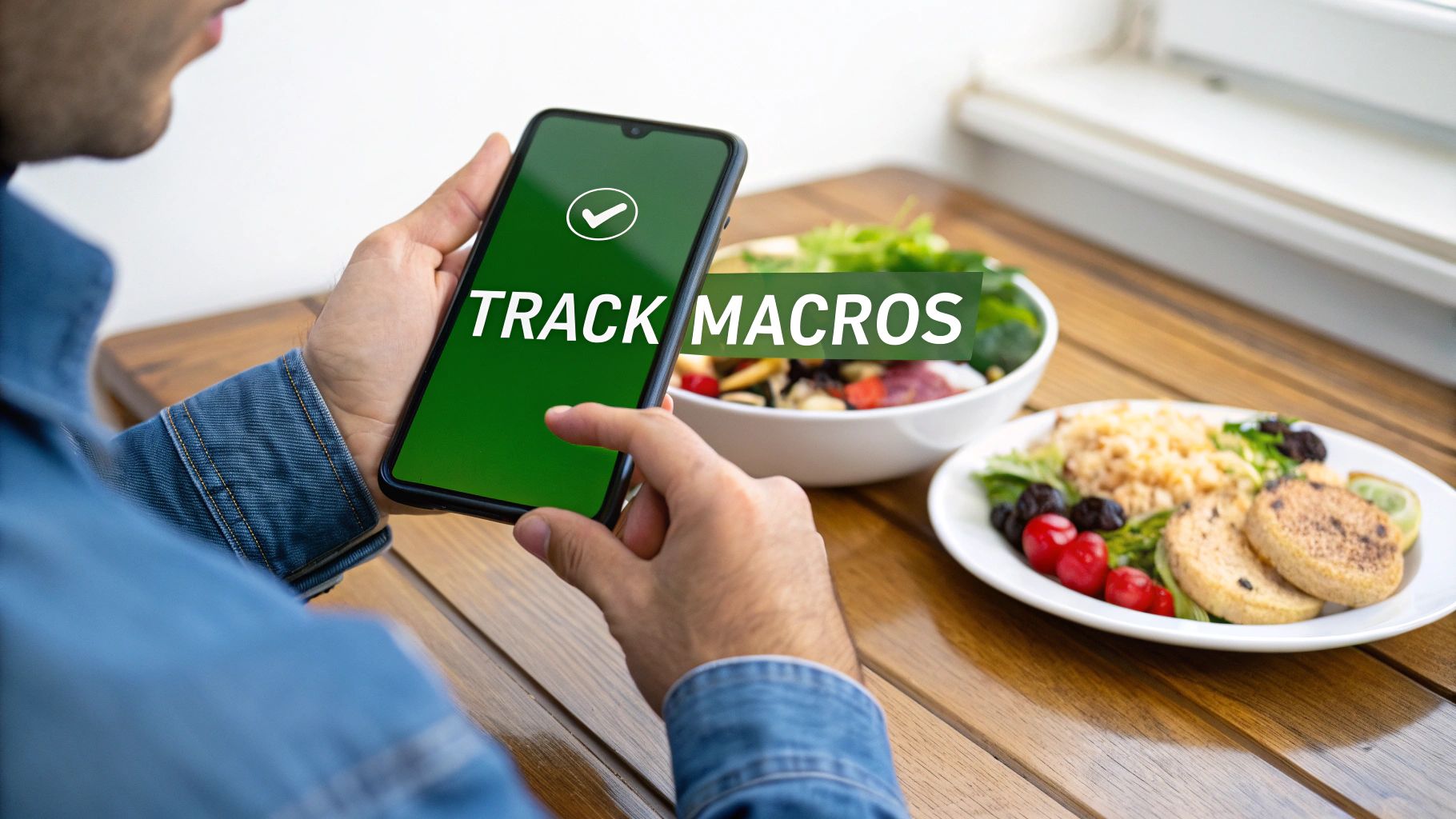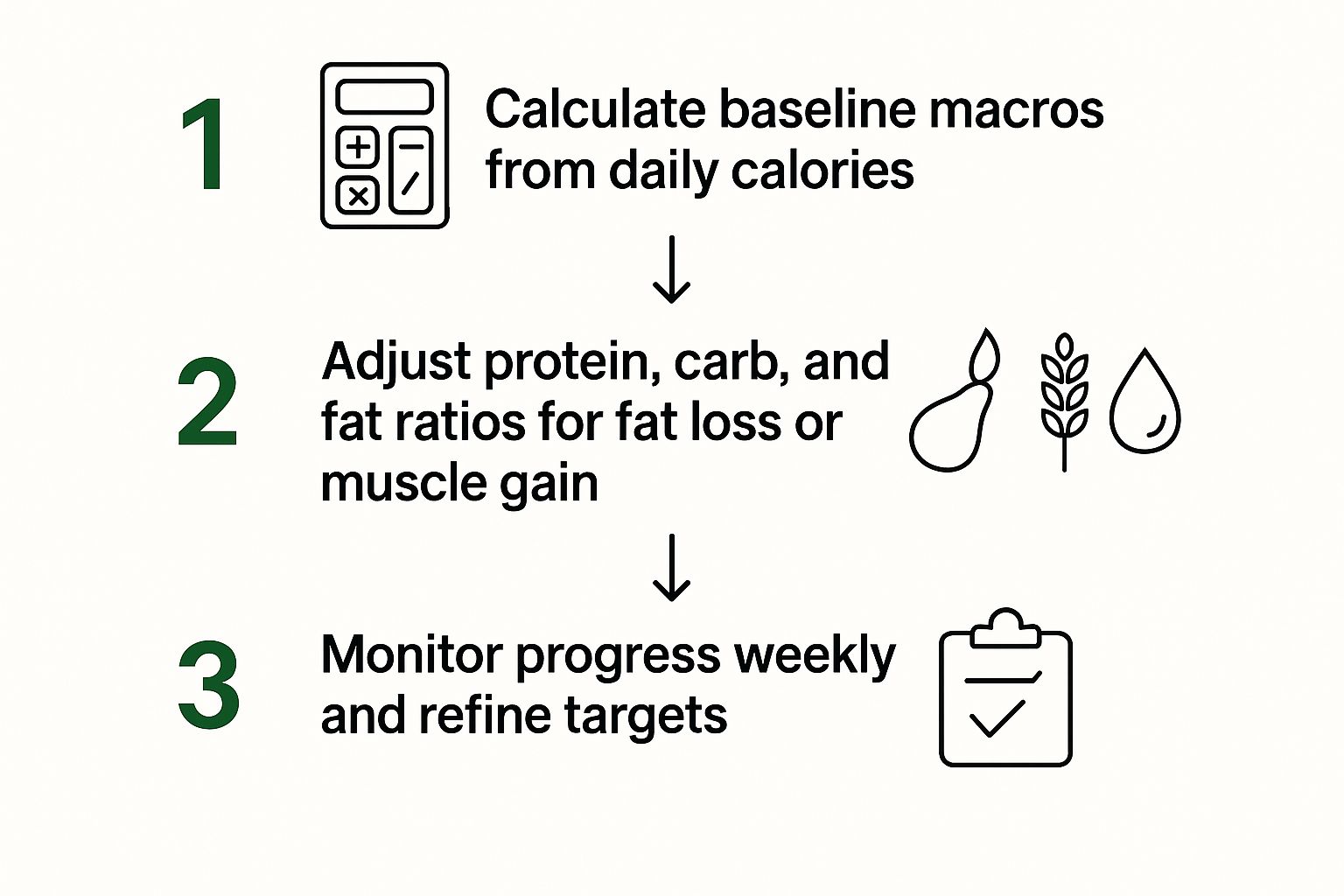How to Calculate Macros for Your Fitness Goals
Tired of confusing diets? Learn how to calculate macros the right way with our simple guide. Get personalized formulas for fat loss or muscle gain.
Ready to Simplify Your Meal Planning?
Get personalized meal plans and grocery lists automatically matched to your macro targets.

How to Calculate Macros for Your Fitness Goals
Tired of confusing diet rules? Let's cut through the noise. Calculating your macros isn't about restriction; it's about creating your body's unique fuel formula.
Your No-Nonsense Guide to Macro Counting
Forget what you think you know about dieting. This isn't about sad salads and forbidden foods. Learning to calculate your macros is about giving your body exactly what it needs to perform, look, and feel its best. Think of it as a flexible blueprint, not a rigid set of rules.
This whole idea isn't some new-age fad, either. It’s built on solid nutritional science. The concept of hitting specific nutrient targets has been around since the 1940s with the first Recommended Dietary Allowances (RDAs). We've just gotten a lot better at personalizing it. You can actually read up on the history of dietary guidelines on Wikipedia if you're a history buff like me.
The beauty of this system is its simplicity once you get the hang of it. We're just going to turn this seemingly complex process into a few easy-to-follow steps.
What Are We Actually Doing Here?
Before we get into the nitty-gritty math, let's break down the game plan. It all comes down to three main phases:
- First, we'll figure out your daily calorie budget. This is the total energy you have to work with.
- Next, we'll lock in your protein goal. This is your non-negotiable for building muscle and feeling full.
- Finally, we'll split the rest of your calories between carbs and fats, based on what feels best for you and your activity level.
That's it. This guide will walk you through each piece, turning those abstract numbers into real, actionable targets for your breakfast, lunch, and dinner.
The real magic of counting macros is the freedom it gives you. It empowers you to understand what your body truly needs to thrive, so you can make smart food choices that get you closer to your goals—whether you're trying to build muscle, drop a few pounds, or just stop feeling so drained all the time.
Ultimately, mastering your macros is about building a sustainable approach to nutrition. It's about creating a balanced plate that genuinely works for you, no deprivation required.
First, let's get a quick refresher on what these macros actually do for you.
The Three Macros and Their Roles
| Macronutrient | Calories per Gram | Primary Role |
| Protein | 4 | Builds and repairs tissues (like muscle), supports immune function, and keeps you feeling full. |
| Carbohydrates | 4 | The body's main and preferred source of energy for your brain and muscles. |
| Fats | 9 | Crucial for hormone production, absorbing vitamins, and providing long-term energy. |
See? Each one has a specific, important job. Now, let's figure out how much of each you need.
Finding Your Personal Calorie Target

Alright, before we start divvying up proteins, carbs, and fats, we need to figure out your total energy budget. Think of it this way: you can't plan how to spend your money until you know what's in your bank account. Your daily calorie target is the absolute foundation of your nutrition plan, so let’s nail this down.
First up, we need to calculate your Basal Metabolic Rate, or BMR. This is the rock-bottom number of calories your body burns just to keep the lights on—we’re talking breathing, circulating blood, and basic organ function. It’s essentially your "coma calories."
Cracking the BMR Code
To get this number, we'll lean on a battle-tested formula: the Mifflin-St Jeor equation. It’s widely considered the gold standard for accuracy. Grab your calculator; it's time for some quick math.
For Men:
(10 x weight in kg) + (6.25 x height in cm) - (5 x age in years) + 5
For Women:
(10 x weight in kg) + (6.25 x height in cm) - (5 x age in years) - 161
Just a heads-up, make sure you convert your weight from pounds to kilograms (your weight in lbs / 2.2) and your height from inches to centimeters (your height in inches x 2.54). Getting the units right is crucial here.
Once you’ve got that number, you've found the first piece of the puzzle. But since you're (hopefully) not lying in a coma all day, we need to account for all the moving around you actually do.
From BMR to Your Real-World Calorie Needs
Now we need to turn that BMR into your Total Daily Energy Expenditure (TDEE). This is the big one—it’s the total number of calories you actually burn in a 24-hour period, factoring in everything from your job to your gym sessions.
To find your TDEE, you just need to multiply your BMR by the activity multiplier that sounds most like you. Be honest with yourself here!
- Sedentary: Desk job, very little intentional exercise. -> BMR x 1.2
- Lightly Active: You get in some light exercise or sports 1-3 days a week. -> BMR x 1.375
- Moderately Active: You're hitting the gym for some solid workouts 3-5 days a week. -> BMR x 1.55
- Very Active: You're doing hard exercise or playing sports 6-7 days a week. -> BMR x 1.725
- Extremely Active: You have a physically demanding job and you’re training hard. -> BMR x 1.9
For example, a software developer who sits most of the day but makes it to the gym three times a week would probably use the 1.375 multiplier. On the flip side, a construction worker who also trains after work is living in that 1.725 to 1.9 range.
The final number you land on is your TDEE, also known as your "maintenance calories." This is roughly the amount you need to eat every day to stay at your current weight. With this number in hand, we finally have the perfect launchpad to start tailoring your diet for fat loss, muscle gain, or whatever your goal might be.
Time to Talk Protein: Your Most Important Macro

Alright, you've got your magic number—your total daily calories. Now for the fun part: deciding how to spend them. The very first place we start is with protein. This isn't just a random choice; it's the single most important macro for changing how you look and feel.
Forget those confusing percentages you see everywhere. The best, most reliable way to set your protein target is based on your body weight. This anchors your diet to what your body actually needs to build and maintain lean muscle. Think of muscle as your metabolic furnace—the more you have, the more calories you burn, even at rest.
Why all the fuss about protein? It's the undisputed MVP. It crushes hunger, keeps you feeling full for hours, and helps prevent those wild blood sugar swings that lead to energy crashes. Plus, your body burns more calories digesting protein than any other macro. It's a win-win-win.
Nailing Down Your Daily Protein Number
So, how much do you need? For anyone with a fitness goal, a solid range to aim for is 0.7 to 1.0 grams of protein per pound of body weight (that's about 1.6 to 2.2 grams per kilogram, for my metric friends).
Your specific goal will determine where you land within that range.
- Goal: Burn Fat. You'll want to aim for the higher end of the scale, somewhere around 0.9 to 1.1 grams per pound. When you're eating in a calorie deficit, getting enough protein is your insurance policy against losing precious muscle along with the fat.
- Goal: Build Muscle. A target of 0.8 to 1.0 grams per pound is the sweet spot. This provides all the fuel your body needs for repair and growth after you've hit the weights.
- Goal: Maintain & Be Healthy. If you're happy where you are, sticking around 0.7 to 0.8 grams per pound is perfect for keeping your body composition in check.
Let’s Make It Real:
Imagine a guy named Alex who weighs 180 pounds. His main goal is to get leaner while building some strength. He decides to shoot for a solid 1.0 gram of protein per pound of his body weight.
>
180 lbs x 1.0 g/lb = 180 grams of protein per day.
Boom. Just like that, Alex has a clear, actionable target to hit every single day. No guesswork.
Now we can figure out how many calories that protein target "costs" him from his daily budget. Since every gram of protein provides 4 calories, the math is simple:
180g of protein x 4 calories/gram = 720 calories.
That's the first piece of the puzzle solved. Next, we'll subtract these 720 calories from his total daily calorie goal to see how much we have left to "spend" on carbs and fats.
Sorting Out Your Carbs and Fats

Alright, you've nailed down your total calories and your protein goal. Honestly, that's the heavy lifting. The rest is all about personalizing your energy sources—carbohydrates and fats—to match your lifestyle and how you want to feel.
First things first, we need to know what we're working with. Let's revisit our example, Alex. He's aiming for 2,200 calories a day with 180 grams of protein, which we know accounts for 720 calories.
A little quick math gives us our energy budget:
2,200 (Total Calories) - 720 (Protein Calories) = 1,480 calories remaining.
Think of these 1,480 calories as your "discretionary energy fund" to be allocated between carbs and fats.
How Should You Split Your Energy?
This is where the art meets the science. There is no single magic ratio for carbs and fats; the best split is the one that works for you. Are you hitting the pavement for long runs and need that quick-burning fuel? Or do you find you feel more satisfied and have steadier energy on a higher-fat diet?
Here are a few common starting points I recommend to clients:
- The Balanced Approach (50/50 Split): This is my go-to starting point for most people. It’s simple, effective, and works wonderfully for general fitness and health. You just split the remaining calories right down the middle.
- The Performance Split (60/40 or 70/30 Carbs/Fats): If your workouts are long and intense, you'll burn through carbs like a furnace. Prioritizing carbs gives you the readily available energy you need to push hard.
- The Lower-Carb Approach (40/60 Carbs/Fats): For those who are more sedentary or simply feel better with fewer carbs, flipping the ratio and emphasizing healthy fats can be a game-changer for satiety and stable energy levels.
My Two Cents: Don't obsess over getting this perfect right away. Pick a ratio, live with it for a couple of weeks, and be honest about how you feel. Are you energized? Dragging? Hungry all the time? Adjust from there. This is a process of discovery.
Let's stick with Alex, who decides to start with a classic, balanced 50/50 split for his 1,480 leftover calories.
From Calories to Grams
Now we just have to translate those calorie numbers into grams for easy tracking. The key is remembering the caloric density of each macro: carbs have 4 calories per gram, while fats pack a bigger punch at 9 calories per gram. If you're curious about the science, you can read up on how these macro values are determined.
Let’s run the numbers for Alex’s 50/50 split:
- Carb Calories: 1,480 calories x 0.50 = 740 calories from carbs
- Fat Calories: 1,480 calories x 0.50 = 740 calories from fats
Finally, we convert those calories into grams:
- Carbs: 740 calories ÷ 4 = 185 grams of carbs
- Fats: 740 calories ÷ 9 = 82 grams of fats (rounding to the nearest gram is fine!)
Boom. We have our final numbers. Alex’s complete daily target is 180g Protein, 185g Carbs, and 82g Fat. He’s officially ready to start planning his meals.
Bringing Your Macro Plan to Life
Alright, enough with the theory. Let's get our hands dirty and walk through a real-world example so you can see exactly how this all comes together. No more guesswork.
Let’s imagine a client—we’ll call her Sarah. She’s 30 years old, weighs 150 pounds, stands at 5'5", and spends most of her day at a desk. Her goal is to shed 15 pounds, and she’s committed to hitting the gym 3 days a week.
Time to crunch the numbers.
Breaking Down Sarah’s Macro Math
First up, we need to figure out her Basal Metabolic Rate (BMR) using the Mifflin-St Jeor formula, which I find is a solid starting point for most people.
For women, it looks like this:
(10 x weight in kg) + (6.25 x height in cm) - (5 x age) - 161
Plugging in Sarah’s stats (150 lbs = 68kg; 5'5" = 165cm), we get:
(10 x 68) + (6.25 x 165) - (5 x 30) - 161 = 1,400 calories. That’s the energy her body needs just to exist.
Next, we need her Total Daily Energy Expenditure (TDEE). She has a desk job but also works out, so the "Lightly Active" multiplier of 1.375 is a good fit.
1,400 (BMR) x 1.375 = 1,925 calories. This is what she needs to eat to maintain her current weight.
But Sarah wants to lose fat. A 20% calorie deficit is a smart, sustainable place to start—aggressive enough to see results but not so drastic that she’ll feel miserable.
1,925 x 0.80 = 1,540 calories per day. That’s our target.
Now for the fun part: the macros. Protein is king, especially in a deficit, because it helps preserve muscle. We'll set hers high at 1.0 gram per pound of body weight.
- Protein Target: 150 lbs x 1.0 g/lb = 150g of protein
- Protein Calories: 150g x 4 calories/gram = 600 calories
With protein sorted, we can figure out our carbs and fats. We just subtract the protein calories from our daily total.
1,540 (Total Calories) - 600 (Protein Calories) = 940 calories left to play with.
I usually recommend splitting the remainder pretty evenly between carbs and fats for balanced energy and hormones. A 50/50 split is perfect here.
- Carbs: 470 calories / 4 calories/gram = 118g
- Fats: 470 calories / 9 calories/gram = 52g
And there you have it! Sarah's starting macros for fat loss:
1,540 Calories | 150g Protein | 118g Carbs | 52g Fat
This handy visual sums up the exact process we just followed.

See? You start with a calorie baseline, set your protein, and then fill in the rest based on your goal. From here, it's all about consistency, tracking how you feel, and making small adjustments along the way.
Alright, so you've crunched the numbers and have your shiny new macro targets. Awesome. But let's be real—the math is the easy part. The real challenge is hitting those numbers without turning your life into one giant, soul-crushing spreadsheet.
So, how do you track this stuff without losing your mind?
First things first, let a little technology do the heavy lifting for you. Trying to track with a pen and notepad is a one-way ticket to burnout. Instead, grab an app like MyFitnessPal or Cronometer. Their food databases are gigantic. You can scan a barcode or type in "chicken breast," and poof—the macros are logged. It takes all of ten seconds.
Staying on Track in the Wild
Tracking is a piece of cake when you're in your own kitchen, but what happens when you venture out into the real world? Eating at a restaurant can feel like you're flying blind, but you've got this.
Most big chain restaurants have their nutrition info online. A quick Google search for something like the "Chipotle nutrition calculator" before you even leave the house can give you a solid game plan.
But what about that amazing local taco spot? This is where you learn the fine art of the "guesstimate."
- A piece of protein (like chicken or steak) that's about the size of your fist is usually around 4-5 ounces.
- A scoop of carbs (rice, potatoes, pasta) that fits in your cupped hand is roughly 1 cup.
- That little bit of oil, butter, or dressing? The tip of your thumb is a good stand-in for about a tablespoon.
It’s not perfect, but it’s a hell of a lot better than just winging it and hoping for the best. Remember, consistency is way more important than perfection.
Look, the goal isn't to hit every single number down to the gram each day. That’s a recipe for disaster. Think bigger picture: Aim to land within a reasonable range and focus on your weekly average. One meal that's a bit off won't derail your progress, but throwing in the towel because of it definitely will.
At the end of the day, tracking is just a tool. It's there to give you feedback and guide your choices, not to trap you in a prison of numbers. Learn the general patterns, get good at estimating, and cut yourself some slack. That's the secret to making this a lifestyle, not just another diet you'll quit in a few weeks.
The Macro Counting Questions Everyone Asks
Alright, let's get into the nitty-gritty. Once you start tracking macros, a bunch of "what if" questions inevitably pop up. I've heard them all, so let's clear the air on the most common ones.
"Do I Really Need to Hit My Numbers Perfectly Every Single Day?"
Heck no. Seriously, don't even try. Chasing 100% accuracy is a one-way ticket to burnout city.
The name of the game is consistency, not perfection. Think of your targets as a range. Being within 5-10 grams for protein and carbs, and maybe 2-5 grams for fats, is a massive win.
What matters most is your weekly average. Did you go a little overboard on carbs yesterday? Who cares. Just get back to it with your next meal. Don't let one slip-up derail your entire week.
"How Often Should I Bother Recalculating All This Stuff?"
Good question. Your body isn't static, so your numbers shouldn't be either. As you lose weight or build muscle, your energy needs will change.
A solid rule of thumb is to take a fresh look at your macros every 4-6 weeks. Another great time to recalculate is after you’ve lost or gained 10-15 pounds. This quick check-in keeps your plan aligned with your progress and helps you smash through those annoying plateaus.
"Crap, I Went Over My Calories. Now What?"
First, take a breath. It happens to the best of us. A single high-calorie meal or day won't undo all your hard work, I promise.
The absolute worst thing you can do is try to "punish" yourself by starving the next day. The best thing you can do? Just get right back on track with your next planned meal. Simple as that.
My Pro Tip: If you're going to stress about anything, stress about your total calories and your protein. Those are the two biggest levers for changing your body. Carbs and fats? They’re much more flexible.
Focus on the big picture, nail the important stuff, and don't sweat the small daily fluctuations. That's how you make this a lifestyle, not a short-term obsession.
---
Tired of punching numbers into a calculator? Let Meal Flow AI do the heavy lifting. We build personalized meal plans based on your exact macro targets and even create a shopping list you can send straight to Instacart. Get your plan and have your groceries delivered from https://mealflow.ai.